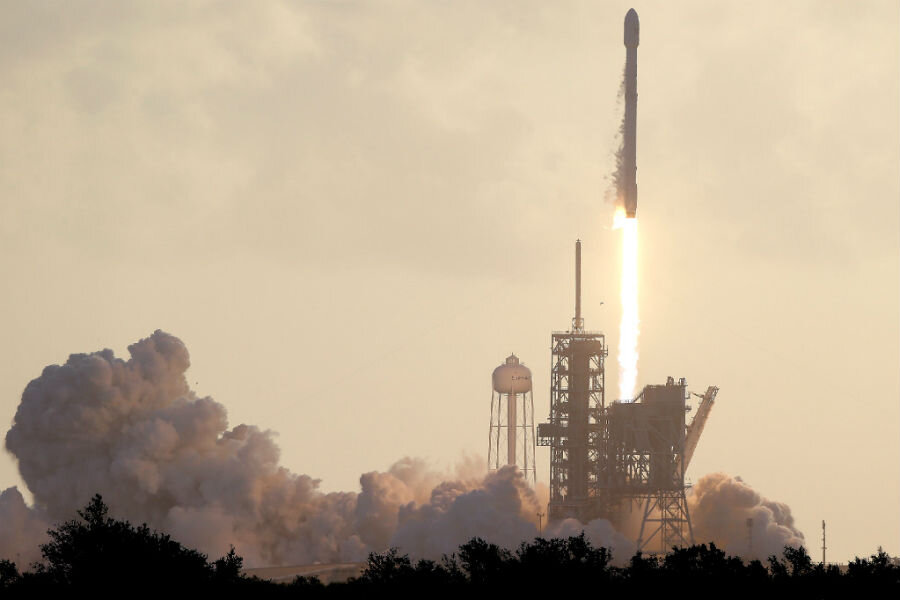SpaceX launches classified spy satellite for US Department of Defense
Loading...
On Monday morning, the private space company SpaceX launched their latest Falcon 9 rocket into orbit. But while the company has launched several payloads into space for a number of clients, this mission was a little bit different. Instead of the more typical communications satellite or scientific equipment, the rocket carried a spy satellite for the National Reconnaissance Office (NRO).
The NRO is an agency of the US Department of Defense. As such, the Monday launch marked the breaking of a 10-year monopoly on launching US military and national security satellites previously held by the United Launch Alliance (ULA), a partnership of Lockheed-Martin and Boeing.
By breaking the monopoly, the launch became something of a coup for both SpaceX and private space companies in general. Governmental organizations like NASA are increasingly turning to private companies for tasks ranging from satellite deployment to human transportation into space, blurring the line between public and private space missions. While NASA has worked with commercial companies before, the degree of responsibility given to private companies like SpaceX has risen considerably in recent years, according to Mariel Borowitz, a technology and space policy specialist and associate professor at the Sam Nunn School of International Affairs at the Georgia Institute of Technology.
"Private space launch companies have been around for a long time – Arianespace became the first commercial launch company in 1980, and Orbital Sciences, Lockheed, and Boeing have been involved in commercial launch activities since the 1990s," Dr. Borowitz tells The Christian Science Monitor in an email.
"What's different now is that NASA is relying fully on commercial entities to provide the ability to launch cargo and crew to low Earth orbit," she adds. "The transition to a reliance on private industry occurred because there was a realization that travel to low Earth orbit has become more routine and can safely be handed off to commercial entities. Relying on companies to transport cargo and humans to the Space Station and other locations in low Earth orbit allows NASA to focus its efforts on cutting edge technologies, like the heavy lift launch capabilities needed to travel to the moon or Mars."
Of course, sending satellites (and eventually astronauts) into orbit at the behest of NASA is one thing, but sending a classified NRO satellite into space carries a different set of challenges. For instance, SpaceX was not allowed to provide any details about the Falcon 9's cargo and gave no news about the rocket's trajectory beyond confirming second stage ignition. In addition, the company was also required to cut off the broadcast of the launch after a few minutes, which is standard practice for NRO missions.
Despite the lack of specifics, the launch appeared to go off without a hitch, after a one-day delay to resolve an issue with an engine sensor. The SpaceX team achieved even the mission's secondary goal of returning the booster to Earth for later re-use – a feature the company has touted as an example of the cost-effective and innovative features of commercial rockets for potential clients, including the US government.
"Working with the private sector in the way NASA has with the Commercial Orbital Transportation Program and the Commercial Crew Program allows the agency to take advantage of innovation and unique capabilities in the private sector," says Borowitz. "Working with more than one launch company ensures that there is competition in the market, which also helps to keep costs down."
But while private innovation and competition have their benefits, she says, the government no longer has such precise control over the design of new launch vehicles. This means that SpaceX, ULA, and other launch providers still have to work closely with NASA to ensure safety and meet other requirements.
"It is important to keep in mind that these arrangements are truly public-private partnerships, especially in the case of launching humans," Borowitz adds. "NASA gains significant benefits by working with the private sector, but the private sector also would not be able to succeed without support from NASA."
This relationship can be a lucrative one for companies sending satellites into space. But corporations like SpaceX also have their sights on space tourism, putting ordinary consumers into orbit and beyond. Commercial space travel has lingered tantalizingly on the horizon for years, but there are a number of obstacles to overcome before it can finally become a reality, says Jeffrey Forrest, head of the Aviation and Aerospace Science department at the Metropolitan State University of Denver.
"[Commercial space travel] will not be as straightforward as airline travel," Dr. Forrest tells the Monitor via email. "Passengers will need training and medical screening. The environment of zero-gravity, even for short periods of time, can be tenuous on folks, even highly trained astronauts.... Long term space flight is far more challenging."
Still, at one time, carrying cargo into space for NASA and the Department of Defense once seemed similarly daunting for spaceflight startups, says Borowitz.
"When NASA chose SpaceX and Orbital Sciences under the Commercial Orbital Transportation Program, which stated that these companies would develop vehicles to transport cargo to the International Space Station, neither company had ever flown the vehicles they were proposing," she says. "These companies have been meeting key development milestones, and we can be confident that they will soon be launching humans to the International Space Station. Once this capability is developed, the companies will be able to transport not only NASA astronauts, but private space tourists, as well."








